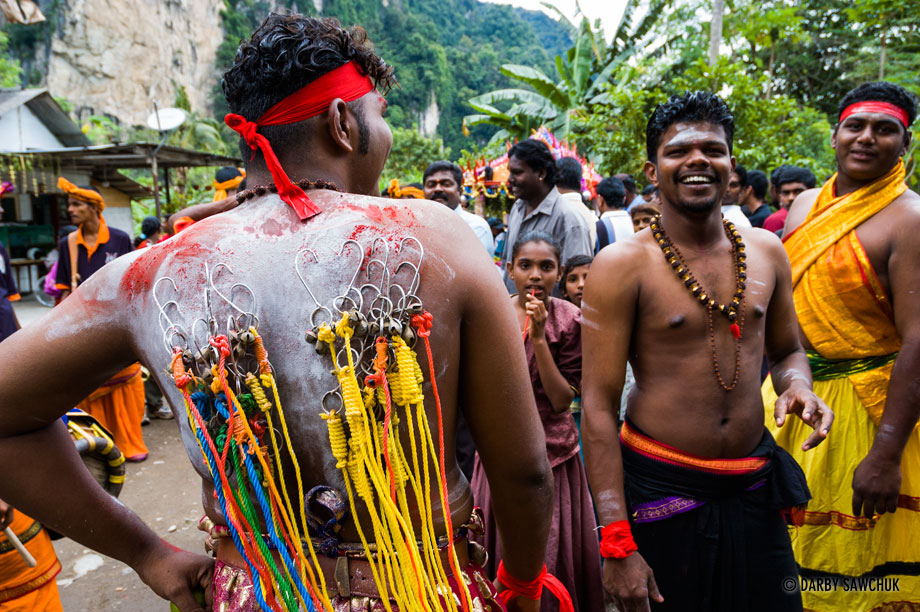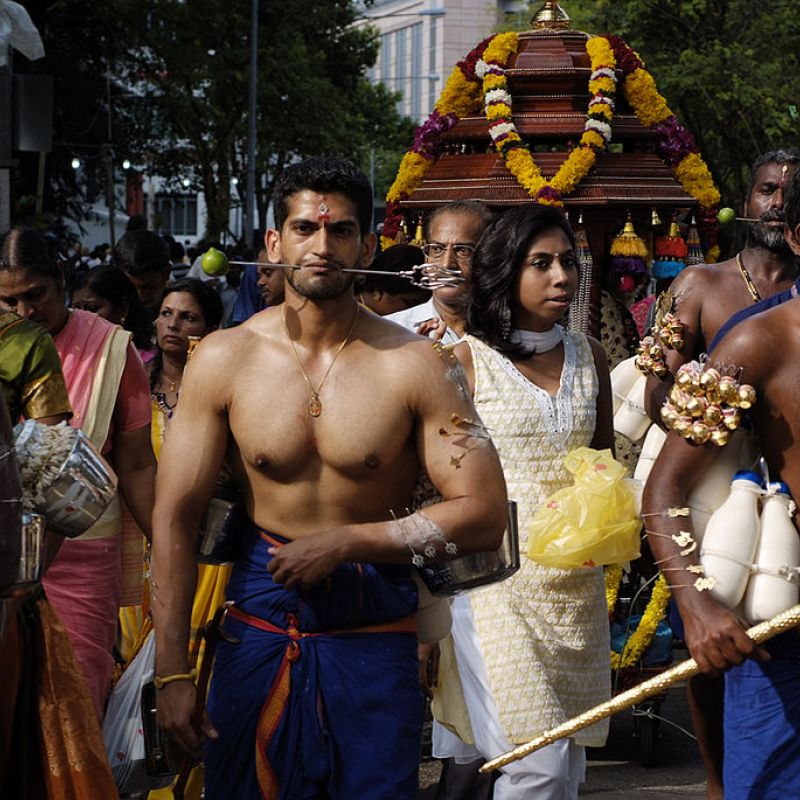We explore the literary, scriptural, spiritual and anthropological connection between Murugan, the primary deity of the Tamil festival of Thai Pusam, and Tamil identity—especially in India and South East Asia (Photo Source: William Cho/Wikimedia Commons)
‘The great drums beat
As Asura warriors marched
Their burning rage cut asunder
Corpses scattered
Scorched with a spark
From your radiant smile
O leader of men
With leaf-edged spear
Lover of Valli, the gypsy
O Lord who resides on Tiruttani hills!’
(Arunagirinathar, Thiruppukal, translation S. Kokilam)
The frenzy and fervour of the Thai Pusam festival (also spelt as Thaipusam, Thaipoosam and தைப்பூசம் in Tamil), wherever the Tamils celebrate it, are unmistakable. The festival draws its name from the month of ‘Thai’ (mid-January to mid-February) in the Tamil calendar and the star ‘Pusam’ on a full moon day, which marks one of the six birthdays of the six-faced Lord Murugan (Skanda-Karthikeya in Sanskrit). Wherever there is a significant presence of Tamil community—be it in Sri Lanka, Malaysia, Mauritius, Singapore, South Africa, Canada, Réunion, Indonesia, Thailand, Myanmar, Trinidad and Tobago, Guyana, Suriname, Jamaica or Europe—Thai Pusam brings the Tamils together, creates conventions and commits it to cultural memory.
In-Text Context
The earliest reference to Murugan in Tamil literature can be found in the Sangam classical period, where Murugan has been mentioned as the Lord of the Kurinchi landscape (mountains and mountainous regions). Interestingly, as the Kurinchi flower symbolises youthful first love in Sangam poetics, and the presiding deity, Murugan, is also the Lord of war, the semantic binaries of love and war, are thus seemingly presented, as the central axis of Tamil culture. The earliest poem of the Sangam Age dedicated to the glory of Murugan, Thirumurugatrupadai (3rd century CE) mentions six pilgrimage sites—Tiruttani Kai, Swamimalai, Thiru Avinankudi (Palani), Pazhamudircholai, Thirupparamkunram and Tiruchendur, which are famous Murugan temples (Arupadaiveedu) even today.

The sacred wounding of the body with piercings is part of Thai Pusam festivities (Photo Source: DaphneBreemen/Wikimedia Commons)
In the Arupadai Veedu (meaning, six battle stations) temples, Murugan, who is the supreme general of Shiva’s army, reigns as the youthful God. As a boy-child God, Murugan in Tamil culture symbolises embodiment of youth, valour, compassion, limitless generosity, destruction of ignorance, wisdom and knowledge, passionate love, equality and justice. In the Sangam age classical Tamil literature, we read that the worship of Murugan essentially consists of pilgrimage on foot, carrying kavadi (wooden arches decorated with peacock feathers) on the shoulders. The practice, which is vibrant even today, had given birth to a literary genre called Kavadi Sindhu in Tamil. Characterised by its fast rhythmic metres, Kavadi Sindhu produces enormous bodily energy for the foot pilgrims, and was also used in the past as motivational songs for the army going to war. Arunagirinathar, a 15th century Tamil saint-poet, composed Thirupukal with complex, fast and poetic metres. In the 19th century, Devaraya Swamigal (born in 1820), composed Kanda Sasthi Kavasam—another popular hymn that glorifies Murugan. Reciting Thirupukal and Kanda Sashti Kavasam during the pilgrimage and on festival days such as Thai Pusam is an integral part of Murugan worship today.
Of War and Marriage
Another aspect of the observance of this festival is the ‘going into a trance’ by devotees. According to mythology, Thai Pusam marks the day Murugan received his vel (lance) from his mother Goddess Parvati. With his lance, Murugan vanquished the demon Surapadman. Known as the Vel Vaangum Vakuppu (Receiving the Lance) in the Murugan mythologies, the devotees recite devotional hymns that narrate the event of the battle, and often slip into trance while doing so. The trance behaviour, known in the Tamil classical literature as Veriyattu, signifies ‘just anger’.
In the mythological stories, Murugan has two wives. His first wife Devayani is God Indra’s daughter, while the second Valli is a gypsy (Kurati). Some interpretations of Murugan mythologies see in his two wives a balance of societal high and low, but Murugan's love affair with Valli and his eventual marriage with her is more revered in many Tamil folk dramas, songs and ritual enactments. The importance of Valli Thirumanam (the marriage of Valli) to Tamil life can be gauged by the report that when the Tamil inundated labourers were taken on a one-way ticket to distant lands such as the Indian Ocean islands, they carried chapbook editions of Valli Thirumanam and Kanda Sashti Kavasam with them. The other 'Tamil essentials' of the inundated labourers included coriander plants, mango seeds, jasmine saplings and chutney grinder (ammikkal). Today, after nearly a century of displacement of the Tamil labourers, the scholars of Tamil diaspora report that the Indian Ocean island nations have vast mango groves, Tamil women with jasmine flowers on their hair and coriander plants in their gardens. Valli Thirumanam survives as a Creole play performed more, like a liturgical recital, during festivals such as Pongal and Thai Pusam. Valli Thirumanam as play and ritual lore united the Tamil communities, asserted their identities and even helped to foster resistance against the oppression of their colonial masters.
Murugan’s Mythologies
One of the major Puranas, the Skanda Purana is dedicated to Murugan. In the Bhagavad Gita (Chapter 10, verse 24), Krishna while describing his omnipresence says, ‘Among generals, I am Skanda, the lord of war.’ In Sanskrit literature, we see references to Murugan as Subrahmanya in Kautilya's Arthashastra, and in the grammatical works of Patanjali. Kalidasa's epic poem, Kumarasambhava, celebrates the birth of Murugan. The Atharva Veda describes Skanda as a son of Agni, the fire god. The Shatapatha Brahmana refers to him as the son of Rudra and the ninth form of Agni. The Chandogya Upanishad refers to Skanda as the way that leads to wisdom.
Despite such long and rich literary resources, we do not know why Skanda worship waned in North India and became one of the most popular forms of worship in Tamil Nadu. Semiotically, one may read in Murugan worship, cultural values that the Tamil society accords to beauty, youth, just war, equality and transformative power of higher wisdom. Tamil poets, again and again, revere Murugan's prowess not only to destroy evil but also change that into things positive. Like a seashell transforming dirt particles into pearls, Murugan shapes the inner demons of his devotees into positive energies. In the ritual enactment of Murugan's final battle with the demon Surapadman during the Kanda Sashti festival, we see that Murugan transforms Surapadman into his flag after slaying him.

In Malaysia, on Thai Pusam, the self-manifested deity of Murugan in a limestone bluff known as Batu caves, 12 km away from Kula Lumpur, becomes the centre of devotion (Photo Source: Pixabay)
Lord Murugan and Tamil Identity
Fred Clothey, author of Many Faces of Murukan: The History and Meaning of a South Indian God, observes that during the Sangam Age, Murugan, the God of Hills, was thought to be a hunter in the mountain woods. He could dispel negative power from nature and person, and possess the devotee. By the third century, Murugan had become the god of the city of Madurai; his hunter attributes replaced by those of the warrior and his role the counterpart of the Pandya King. Arunagirinathar of the early 15th century extolled Murugan, celebrated Tamil language and landscape in his poetry almost, equating the Tamil language with Lord Murugan. In many ways, Arunagirinathar was a forerunner of an eventual Tamil renaissance in the 19th century that reconstructed Tamil identity firmly. Murugan's Arupadai Veedu (the six-battle stations) unify and create sacred geography of Tamil Nadu that is vigorously within the grace of his divinity.
In Malaysia, on Thai Pusam, the self-manifested deity of Murugan in a limestone bluff known as Batu caves, 12 km away from Kula Lumpur, becomes the centre of devotion. Several hundred thousands of pilgrims carry pots of milk and Kavadi as offerings to Murugan and climb about 272 steps to the shrine. Going into trance, the sacred wounding of the body with piercings are normal just as it is in Murugan temples on Thai Pusam in Tamil Nadu.
So, what does the Thai Pusam festival tell us about Tamils? Wherever they go, Tamils carry their language, cultural memory and identity with them.
Views expressed are personal.












